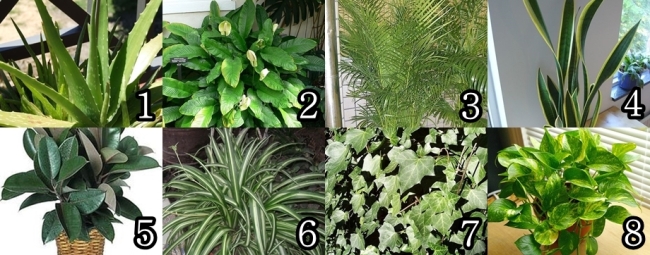Many people are eager to try detox diets, or cleansings, but few experience the sort of results achieved by celebrities.

Without regular and exact administration of a detox program, it can be difficult to achieve improvements in physical well-being.
If you wish to detox your body but don’t have enough time or energy for the long journey of detoxification, it’s possible to start by placing a detoxifying houseplants in your home. Here are eight plants that can help you detox, as suggested by healthcentral.com.
If you wish to detox your body but don’t have enough time or energy for the long journey of detoxification, it’s possible to start by placing a detoxifying houseplants in your home. Here are eight plants that can help you detox, as suggested by healthcentral.com.

1. Aloe vera
Aloe acts as an air purifier. It absorbs chemicals from cleaning products and even gives out warning signs by developing brown patches if the amount of chemicals in the air reachs a high level.
2. Peace lily
This particular kind of lily absorbs pollutants such as formaldehyde (found in carpeting), trichloroethylene (found in plastics), benzene (found in paints) and xylene (found in adhesives). It is easy to care for and can thrive in all sorts of lighting, but is toxic when consumed.
3. Areca palm
Rated by NASA as having the eighth-highest removal rate for formaldehyde -- a chemical often found in carpeting -- it also releases a lot of oxygen and helps restore moisture to dry winter air at levels comparable to an electric humidifier.
4. Mother-in-law’s tongue
If areca palm is a daytime oxygen tank then mother-in-law’s tongue is an evening oxygen tank which is perfect for the bedroom. Mother-in-law’s tongue can withstand most environmental conditions, from light to dark and from wet to dry.
5. Rubber plant
Together with the aesthetic features of the rubber plant, it purifies the air by filtering out formaldehyde, benzene and ammonia. However, it should be kept away from animals or children as it is poisonous when consumed.
6. Spider plant
A popular houseplant in South Korea, the spider plant is tough and hard to kill. It removes benzene, formaldehyde, carbon monoxide and xylene -- a solvent found in leather and rubber.
7. English ivy
This relatively easy-to-grow plant is excellent at removing benzene from the air and also reduces airborne particles of fecal matter. It is also an attractive, decorative plant.
8. Golden pothos
This fast-growing vine absorbs formaldehyde, benzene and xylene, and should be placed near or in the garage since engine exhaust is the primary source of formaldehyde around the home.
By Ha Ji-won, Intern reporter (jiwonha@heraldcorp.com)
Aloe acts as an air purifier. It absorbs chemicals from cleaning products and even gives out warning signs by developing brown patches if the amount of chemicals in the air reachs a high level.
2. Peace lily
This particular kind of lily absorbs pollutants such as formaldehyde (found in carpeting), trichloroethylene (found in plastics), benzene (found in paints) and xylene (found in adhesives). It is easy to care for and can thrive in all sorts of lighting, but is toxic when consumed.
3. Areca palm
Rated by NASA as having the eighth-highest removal rate for formaldehyde -- a chemical often found in carpeting -- it also releases a lot of oxygen and helps restore moisture to dry winter air at levels comparable to an electric humidifier.
4. Mother-in-law’s tongue
If areca palm is a daytime oxygen tank then mother-in-law’s tongue is an evening oxygen tank which is perfect for the bedroom. Mother-in-law’s tongue can withstand most environmental conditions, from light to dark and from wet to dry.
5. Rubber plant
Together with the aesthetic features of the rubber plant, it purifies the air by filtering out formaldehyde, benzene and ammonia. However, it should be kept away from animals or children as it is poisonous when consumed.
6. Spider plant
A popular houseplant in South Korea, the spider plant is tough and hard to kill. It removes benzene, formaldehyde, carbon monoxide and xylene -- a solvent found in leather and rubber.
7. English ivy
This relatively easy-to-grow plant is excellent at removing benzene from the air and also reduces airborne particles of fecal matter. It is also an attractive, decorative plant.
8. Golden pothos
This fast-growing vine absorbs formaldehyde, benzene and xylene, and should be placed near or in the garage since engine exhaust is the primary source of formaldehyde around the home.
By Ha Ji-won, Intern reporter (jiwonha@heraldcorp.com)


![[Exclusive] Korean military set to ban iPhones over 'security' concerns](http://res.heraldm.com/phpwas/restmb_idxmake.php?idx=644&simg=/content/image/2024/04/23/20240423050599_0.jpg&u=20240423183955)




![[Pressure points] Leggings in public: Fashion statement or social faux pas?](http://res.heraldm.com/phpwas/restmb_idxmake.php?idx=644&simg=/content/image/2024/04/23/20240423050669_0.jpg&u=)



![[Herald Interview] 'Amid aging population, Korea to invite more young professionals from overseas'](http://res.heraldm.com/phpwas/restmb_idxmake.php?idx=644&simg=/content/image/2024/04/24/20240424050844_0.jpg&u=20240424200058)






